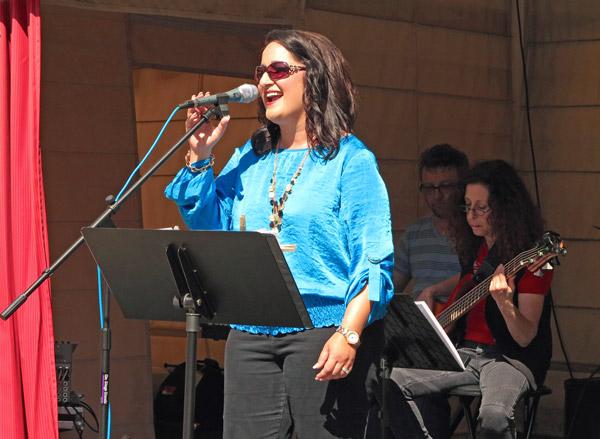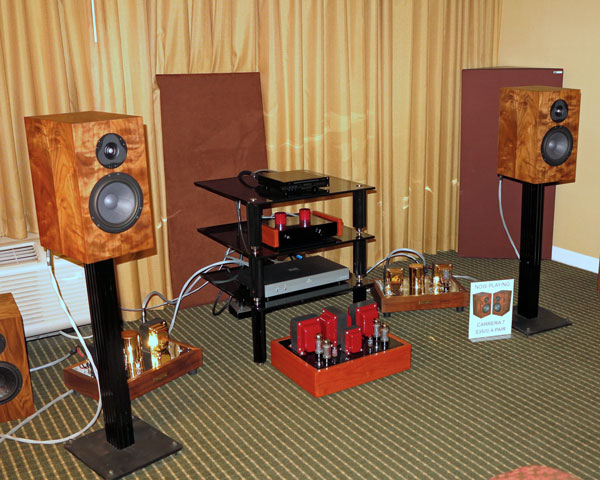| Columns Retired Columns & Blogs |
Putting the car at the end of the blog.
Hey John? Jason needs to review some Emotiva equipment.. Heh heh..


Cake Audio of San Clemente scored big by pairing the Rockport Technologies Atria loudspeakers ($21,500/pair) with the Balanced Audio Technologies (aka BAT) REX I preamplifier ($20,000) and VK-655SE amplifier ($16,500). Together with a new Brinkmann Balance turntable set-up ($35,500 total) allied to a Dynavector XV-1t phono cartridge ($9250) and Brinkmann Edison phono stage ($12,990), as well as an Esoteric K01 transport/DAC ($19,500) and maximally transparent Nordost Valhalla 2 cabling, the system impressed on Lou Reed's perennial, perpetually played "Walk on the Wild Side." Gratifyingly warm highs, great bite on sax, and fine air were the source of immediate pleasure. In addition, exceptional spaciousness and just the right balance between romantic warmth and analytical detail distinguished a track on an LP by Eagles founding member Glenn Frey. This system left me very, very happy.

"Boutique manufacturer" and dealer Electra-Fidelity of Las Vegas demmed a system that alternated their own Electra-Fidelity A3-500 300B monoblocks ($9995/pair) with Atma-Sphere M-60 Mk.III.2 monoblocks with V-Cap upgrade ($7590/pair). Speakers were the unusual-looking AudioKinesis Zephrin 46 loudspeakers ($4500/pair).
The way the speakers' LCS Late Ceiling Splash radiation pattern, which was invented by James Romeyn and Duke LeJeune (implementing reverberant field theories by Dr. Floyd Toole and Dr. Earl Geddes), threw images way high, as well as their amazing three-dimensionality, was quite impressive. Nonetheless, with the Atma-Spheres in the system, the sound on a Patricia Barber CD was too rich for my blood. Also in the system were an Atma-Sphere MP-3 Mk.III.2 preamplifier with built-in tape head preamp ($5660), Otari MX-5050 Mk.III tape transport, and Resolution Audio Cantata Music Center ($6995).

In a room shared by Sunny Components of Covina and VANA Ltd. distributors, a first production run pair of Vienna Acoustics' Imperial Series Liszt loudspeaker system ($15,000/pair) shared the spotlight with the equally fresh Dan D'Agostino Master Audio Momentum integrated amplifier ($45,000). A 16/44.1 file of Gulda playing the adagio from Mozart's Piano Concerto 23, conducted by Harnoncourt, exhibited great spaciousness, as well as wonderful highs with gorgeous, liquid, crystalline overtones. But the midrange sounded, to quote my notes, "weird."
I know. What does that mean? Well, on a 45rpm pressing of that old stand-by, Ella & Louis, Ella sounded wonderful, but there was an extra, unnatural boost in her midrange. Booming on the bottom did not help matters.

FritzSpeakers seems to have a new model at every show I cover, which means lots of new models. This time, the Fritz Carrera 7 ($3500/pair) kept company with the Electra-Fidelity A3-500 300B 8 watt monoblocks ($9995/pair) I missed hearing in their own room. With an Electra-Fidelity Magnetic line amp (a fancy way of saying "preamp"—$1795), WyWires Silver Series cabling, and Parasound Zcd CD player ($400), the sound on a jazz track was nice and smooth, with notable dimensionality around brushes.

Anders Ertzeid of Hegel demonstrated their Hegel H 300 Integrated amplifier ($5500), using a MacBook Air to stream 16/48 files to Raidho X1 loudspeakers ($6400/pair) via Ansuz cables (made by the same company that manufactures Raidho). As far as I can tell from my notes—I received no literature—in six months, a service with the unfortunate name of WIMP—the name may change—will reach the US. WIMP accesses a database similar to Spotify that stores data as 24/96 files, and then streams them as the 16/48 files we heard in the room.
Listening to Prince's "A Case of You," bass was out of control, but everything above it sounded very, very nice. Noting great spaciousness on another, unidentified track, I scribbled in my notes, "Sounds really great." It's clear that CD-quality streaming could change the landscape faster than you can say, "Hegel."

A pre-production pair of Pietra Verde loudspeakers ($45,000/pair estimated price) stood out for their unique, rigid solid granite enclosures, each with a different grain pattern, that help eliminate panel resonance. Demmed by their co-designers, acoustical engineer Jeff Candy and fabricator Richard Nenzel, the Pietra Verdes are hand-made and tested in San Diego using proprietary algorithms and numerical modeling tools.
The speakers partnered with Emotiva's XDA-2 DAC and XPA-1L monoblocks. I didn't write much in my notes about the music, but I recall wondering if the "nice classical music" the boys were playing would have made a greater impression had the price of the electronics been more commensurate with that of the speakers.

And thus we end Day Two as we began Day One, with a hybrid mix of the old, as in a vintage automobile, and the new, as in audio custom-fitted to each car’s acoustics by Reus Audio Systems of Orange, CA.

Putting the car at the end of the blog.
Hey John? Jason needs to review some Emotiva equipment.. Heh heh..

Those same exact drivers are in many DIY designs you can find all over the internet, what is the justification for such a high cost? You can have cabinets made-to-order that look just like those for about 500 bucks. Add in the drivers and top of the line crossover kit that's also pre-made for you, and you're at half that price. Even less if you can put it together yourself. What's the justification for this high of a markup?

A manufacturer must charge much, much more than the raw part cost. He also probably doesn't have his cabinets made in China, like the ones you are talking about. Almost all of the top high end speaker companies use the same parts you can buy yourself. Sony's top speakers for instance, use Scan Speak, not Sony drivers. They charge $30,000 for the top model in the range, and they are a huge, highly efficient company. There is also crossover design expertise, which is as valuable as the drivers themselves. A guy can buy everything you are talking about, put it together himself, and it will sound like crap most of the time, because he has no idea what is actually involved with good speaker design. The variables involved are astounding. You are right that there are some great kits with pre built crossovers though, like the ones from Meniscus.

Why such a large margin though? Are you telling me that every other product in the worst should be marked up like speakers?
You're talking to me like I don't understand how to design or build a speaker. Please do not make such assumptions. I fully understand what I'm doing. If you have a basic electronic background, learning about crossover design is not very difficult.
The cabinets that i'm talking about are not from China. There are tons of cabinet makers that can put out a RECTANGULAR BOX WITH SOME HOLES CUT OUT OF IT for PRETTY CHEAP, right in the USA...
Also thanks for the lecture about Scanspeak drivers. I had no idea that other companies used them. I mean, I LITERALLY JUST POINTED OUT SCANSPEAK DRIVERS BEING USED IN THOSE SPEAKERS.
Wow.

For drivers employed by Fritz there are no known DIY designs employing Fritz' "series" crossover, a large reason for the speaker's superb performance. No loudspeaker design software includes programs for such crossover because the entire circuit including all drivers is in series. Changing one component value disturbs the entire design, requiring many hours of labor for compensation and adjustment. Series circuit design is more labor intensive than any common parallel DIY circuit.
If the opportunity arises, do an A-B test of your favorite DIY design with drivers shared by Fritz.

I can almost see you all cracking up while you type this sort of shit to fool idiotic rich guys into paying thousands of dollars for a few capacitors and inductors. If they're that great, please post a photo of them. I'd like to see this multi-thousand dollar crossover.

Have you heard Fritz' speakers? When and where? If yes, which DIY design ranks with Fritz' speakers, in your esteemed opinion? Did you directly A-B compare some DIY design vs. Fritz? Which exact models did you compare? What is the parts cost including shipping/insurance fees for the particular DIY design you mention? What is the cost for tools? Who fixes it if it DIY fails or does not work as planned?
Some persons who enjoy such products have absolutely no interest in DIY and its inherent risk, including practically no resale value. Some persons might be interested but they have no tools, time, nor space for such endeavor. Where can persons sample DIY designs prior to purchase? Or should they just purchase sight unseen and sound unheard based on opinions like yours?

Don't turn this around and answer my question with a question. Please show how and why these are innately better than the many DIY designs out there that use the same drivers. And please show that a person can tell the difference between them. You have yet to do this.

Our sincere thanks to Jason for spending his valuable time in our room, and his kind and gentle spirit among audio journalists.
Re. Jason's comment that the Patricia Barber CD was too rich: my show partner/vendor Tony Chipelo mentioned PB was streamed from the HD, and the "too rich" sound Jason noticed is endemic to the software.

Please shut this moron, Jazz Purist, down.
Jason, alway look forward to your reviews but in this case, for this afternoon, you write it with impatient and somewhat dismissively. Bad day?
Best,

"The speakers partnered with Emotiva's XDA-2 DAC and XPA-1L monoblocks. I didn't write much in my notes about the music, but I recall wondering if the "nice classical music" the boys were playing would have made a greater impression had the price of the electronics been more commensurate with that of the speakers. "

What, you didn't know that price = quality?

Review John !!!!
It's been written so much about Fritz now that it's review time
How about a rewview of Fritz S/R loudspeakers ?????

JazzPurist, there was a story once about a specialist that charged $15,000 to find the problem in broken machine in a mission critical production line, so when he provided the invoice he was required to make an explanation.....
$ 5 : Making an X, at the area of issue
$ 14,995 : Knowing where to put the X
Knowledge has a considerable associated cost to it, this also goes with speakers